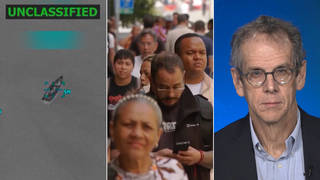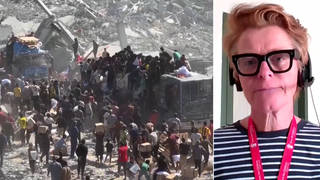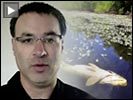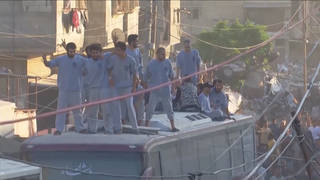
Guests
- Richard Chartersenior policy adviser for Marine Programs for Defenders of Wildlife. He has worked on offshore drilling issues with local and state elected officials and the conservation community for over thirty years and is also engaged in restoring coastal ecosystems.
- Pedro NavaCalifornia Assembly member. He is a Democrat representing Santa Barbara and Ventura Counties and leads a coalition of over 100 environmental groups opposing the first new oil drilling in California Sanctuary Act Waters in more than forty-one years.
The massive BP oil well leak in the Gulf of Mexico has reached the Louisiana coastline as fears grow of a worse disaster than the 1989 Exxon Valdez oil spill. 5,000 barrels of oil a day continue to spew into the water beneath the site of the Deepwater Horizon rig that exploded and sank last week. President Obama said BP is ultimately responsible for funding the response and cleanup operations, but vowed to increase federal involvement. [includes rush transcript]
Transcript
AMY GOODMAN: We move on now to the massive BP oil well leak in the Gulf of Mexico, which reached the Louisiana coastline Thursday night as 5,000 barrels of oil a day continue to spew into the water beneath the site of the Deepwater Horizon rig that exploded last week. Experts are concerned that if the well continues to flow unabated at the same rate for two months, the spill could surpass the 1989 Exxon Valdez disaster as the nation’s worst oil spill ever. BP said Friday it’s begun preparing for the ecologically fragile coastlines of Louisiana, Mississippi, Alabama and Florida for the arrival of an oil slick as the escalating crisis wiped billions of dollars off its market value.
On Thursday afternoon, before the oil began washing ashore the Mississippi River Delta, Louisiana Governor Bobby Jindal declared a state of emergency. Speaking at an unrelated event at the White House Rose Garden Thursday, President Obama said BP is ultimately responsible for funding the cost of response and cleanup operations, but added that the federal government would intensify its response.
PRESIDENT BARACK OBAMA: Earlier today, DHS Secretary Napolitano announced that this incident is of national significance, and the Department of Interior has announced that they will be sending SWAT teams to the Gulf to inspect all platforms and rigs. And I have ordered the Secretaries of Interior and Homeland Security, as well Administrator Lisa Jackson of the Environment Protection Agency, to visit the site on Friday to ensure that BP and the entire US government is doing everything possible not just to respond to this incident, but also to determine its cause. And I’ve been in contact with all the governors of the states that may be affected by this accident.
AMY GOODMAN: The leak is taking place just weeks after President Obama unveiled a new plan to open up large swaths of the Atlantic, Gulf and Alaskan coasts to offshore oil and gas drilling for the first time in decades.
Well, for more on this massive spill and its ecological, economic and political consequences, I’m joined on the phone from Bodega Bay, California by offshore drilling expert Richard Charter. He’s a senior policy adviser for Marine Programs at the group Defenders of Wildlife. He’s worked on offshore drilling issues with local and state elected officials and the conservation community for over thirty years and is also engaged in restoring coastal ecosystems.
Richard Charter, welcome to Democracy Now! Can you explain exactly what happened and the extent that we understand of this spill right now?
RICHARD CHARTER: First of all, this is a human tragedy, and our thoughts and prayers go out to the families of those who have been missing since the initial incident. Eleven people are presumed dead, and so we need to start with that.
As of right now, we’re faced with an ecological and economic threat of potentially historic proportions. We’ve got a 20,000-square-mile oil slick that began to come ashore near the mouth of the Mississippi River last evening, and right in its path immediately are ten state and national wildlife refuges and management areas. And the defense of those is going to be of utmost importance in the coming hours.
We’ve got five states that could potentially be hit by this spill. Those states have fragile economies that are primarily in the coastal areas based on a clean ocean, and the clean ocean has become a thing of the past in that region for the foreseeable future, as you’ve got, as you mentioned, 5,000 barrels a day continuing to flow from the sea floor into that slick. So this is not a one-time event like the Exxon Valdez, where you spill the oil and you start trying to clean it up. This is being fed every day by a continuing flow of oil into the Gulf.
AMY GOODMAN: And what about the Obama administration’s response?
RICHARD CHARTER: It is too early to judge the response as to effectiveness. There appear to be personnel from all over the country from many federal agencies traveling to the area. I would point out that there are limits to what human beings can do in the face of natural forces, such as we have in front of us in the ocean. Wind, currents and weather are going to play the major role in where and how, you know, damaging this spill comes ashore. So it seems to me that everything that can be done is being done. The question is whether that’s enough, because of the size of the slick.
AMY GOODMAN: What does this compare to, in terms of other accidents?
RICHARD CHARTER: This is one for the history books. The only thing that it can compare to, really, is an event called the Ixtoc blowout, which occurred in Mexican waters in 1979 and actually continued for eight months. We did have a smaller blowout — this was a loss of well control — in Australian waters last fall off the Kimberley Coast. It got very little press coverage in the US, but it was obviously of major importance. It went as far as Indonesian waters, eventually covered 8,000 square miles with oil on the Timor Sea, and it went on for ten weeks. So I think we’re in this, it looks like, unless some miracle occurs or the oil companies come up with a response to shut in this well that we have not yet discovered — we’re in this for two or three months, at a minimum.
AMY GOODMAN: It’s ironic, Richard Charter, that this is becoming known as the Earth Day spill.
RICHARD CHARTER: Well, it’s even more ironic than that, because Earth Day — this was the fortieth anniversary of Earth Day, and those who remember the beginnings of Earth Day, there was a triggering event along with the publication of a book called Silent Spring by Rachel Carson. The triggering event that began Earth Day was a blowout in Santa Barbara, California, that became known as the Santa Barbara blowout. And then, on the fortieth anniversary of Earth Day, by some quirk of fate, we are faced with what could be the worst offshore oil drilling disaster in history. So we’ve got, you know, in terms of ecological damage, this is the big one.
AMY GOODMAN: Richard Charter, can you talk about the record of BP?
RICHARD CHARTER: British Petroleum, while this is an industry-wide problem — there are risks associated with this industry and smaller spills and even deaths and injuries of workers happen virtually all the time throughout the world, and even in the Gulf of Mexico. This particular industry has a risk associated with it. But BP has a very checkered past. There was an event in recent years called the Texas City explosion in a refinery where a number of workers were killed in a very tragic way, many people think unnecessarily. We had a very large pipeline spill in the Arctic from a BP pipeline that had apparently not been properly inspected, and corrosion — anti-corrosion measures had not been taken. So there’s kind of a pattern emerging, particularly with BP, but it extends throughout the offshore drilling industry. There’s just certain risks that come along with drilling offshore, and that is why Congress, of course, in a bipartisan manner, maintained a twenty-seven-year moratorium on offshore drilling in sensitive areas along the Atlantic and Pacific coasts, that President Obama is now, of course, on the Atlantic Coast proposing to open up waters from Delaware to Florida, only three miles from shore.
AMY GOODMAN: We’re also joined, in addition to Richard Charter of Defenders of Wildlife, on the line from Santa Barbara by California State Assembly member Nava. Pedro Nava has lead the opposition of more than a hundred environmental groups to a proposal by Plains Exploration and Production Company to drill for oil in California coastal sanctuary waters on a platform located only three miles from the Santa Barbara coast. If the proposal is approved, it would be the only new offshore oil drilling in state waters on the entire West Coast.
State Assembly member Nava, welcome to Democracy Now! How does the BP spill relate to what is happening here in California?
ASSEMBLY MEMBER PEDRO NAVA: Well, thank you for having me on.
And I think the implications are clear. If this spill had happened on the California coast, we wouldn’t be talking about how long it would take to reach our beaches. It would already be there. And all of the efforts at cleanup would be mirrored again in California.
And I think what the BP spill shows us is that the oil company, when they talk about their current technology, they refer to the 1969 Santa Barbara spill as, you know, that was stone-age technology, things are so much better now. So we’re supposed to believe that they have Starship Enterprise efforts. And they’re bleeding 5,000 barrels a day. So things haven’t gotten any better with the oil industry. There is no such thing as state of the art. In fact, that should be seen as the new industry obscenity, because every time they have a spill, they talk about how it was state of the art. So we don’t understand why there is such a strong push to drill in California Sanctuary Act waters, and we’re going to continue to fight it.
AMY GOODMAN: President Obama, his policy opening up the water for offshore drilling, has this surprised you? And how does it compare to the Bush policy?
ASSEMBLY MEMBER PEDRO NAVA: Well, we were extremely disappointed. And we’re not very happy that he threw the California coast a bone by saying that we’re going to be off limits until 2017. We should be moving away from a reliance on fossil fuels. And if we learn anything from this newest spill, there’s nothing safe about trying to do it. I mean, if we were to just increase fuel efficiency by very, very limited measures, we could significantly reduce oil consumption. In fact, if we were to increase fuel efficiency by a mere four percent a year, we could reduce oil consumption by 2.5 million barrels a day. That’s the goal and the direction that we should be headed, not giving the blessing for new drilling anywhere.
AMY GOODMAN: You are holding a hearing today, State Assembly member Nava?
ASSEMBLY MEMBER PEDRO NAVA: Yeah, the timing is rather propitious. In California, I’m the chair of the Assembly Committee on Environmental Safety and Toxics, and we have a number of communities in our state who are threatened by offshore oil drilling, as well as onshore oil drilling. And in my hearing today, we’re going to talk to some of the people who will be responsible for clean-up, should and when we have an incident like this in California, because I don’t care what anybody says, it’s not a question of “if” you’re going to have a spill, it’s a question of “when” you have them, because we always will. And there are at least three communities in my state that have been overwhelmed by Big Oil and their money and their politics and their influence. And I’m going to give them an opportunity to talk about the consequences to the residents of the places where they live when the city officials are trying to protect their health and their safety.
AMY GOODMAN: Well, I want to thank you both for being with us, California State Assembly member Pedro Nava, speaking to us here in California in Santa Barbara. And thank you very much to Richard Charter, who is with Defenders of Wildlife here in the state.












Media Options